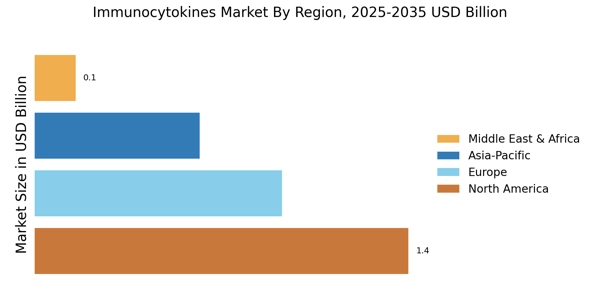Advancements in Biotechnology
Technological advancements in biotechnology are propelling the Immunocytokines Market forward. Innovations in genetic engineering, protein engineering, and monoclonal antibody development are enhancing the efficacy and specificity of immunocytokines. These advancements enable the creation of more potent and targeted therapies, which are crucial in addressing complex diseases. The biotechnology sector has seen substantial investments, with funding directed towards research and development of novel immunocytokines. This influx of resources indicates a robust pipeline of products that could potentially transform treatment paradigms, thereby driving the Immunocytokines Market.
Increasing Prevalence of Cancer
The rising incidence of cancer across various demographics appears to be a primary driver for the Immunocytokines Market. As cancer remains a leading cause of mortality, the demand for innovative treatment modalities is escalating. Immunocytokines Market, which combine the targeting capabilities of antibodies with the therapeutic effects of cytokines, are gaining traction as promising options. According to recent data, the cancer therapeutics market is projected to reach substantial figures, with immunotherapy playing a pivotal role. This trend suggests that the Immunocytokines Market is likely to experience significant growth as healthcare providers seek effective solutions to combat cancer.
Growing Awareness of Immunotherapy
There is a notable increase in awareness regarding immunotherapy among healthcare professionals and patients, which is influencing the Immunocytokines Market. Educational initiatives and clinical trial results are disseminating information about the benefits of immunocytokines in treating various conditions, particularly cancer. As patients become more informed, they are more likely to seek out these advanced therapies. Market data suggests that the immunotherapy segment is expanding rapidly, with immunocytokines being a key component. This growing awareness is likely to enhance the adoption rates of immunocytokines, further propelling the market.
Rising Investment in Cancer Research
The surge in investment directed towards cancer research is significantly impacting the Immunocytokines Market. Governments, private entities, and non-profit organizations are allocating substantial funds to explore innovative treatment options, including immunocytokines. This financial support is fostering collaborative research initiatives and accelerating the development of new therapies. Recent statistics indicate that funding for cancer research has reached unprecedented levels, which is likely to result in a robust pipeline of immunocytokine products. As research progresses, the Immunocytokines Market is expected to benefit from the introduction of novel therapies that address unmet medical needs.
Regulatory Support for Innovative Therapies
Regulatory bodies are increasingly providing support for the development and approval of innovative therapies, which is beneficial for the Immunocytokines Market. Streamlined approval processes and incentives for breakthrough therapies are encouraging pharmaceutical companies to invest in immunocytokine research. This regulatory environment is conducive to the rapid introduction of new products into the market. Data indicates that the number of approved immunotherapy products has been on the rise, reflecting a favorable trend for the Immunocytokines Market. As regulations evolve to support innovation, the market is likely to expand, offering new treatment options for patients.


















Leave a Comment